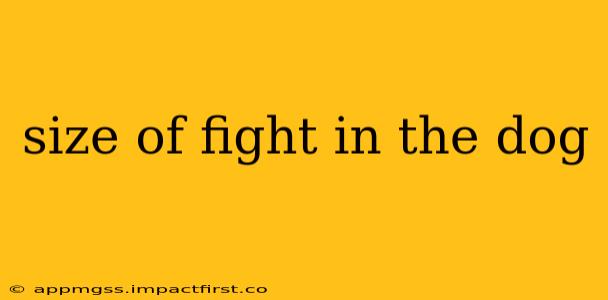Decoding Canine Combat: Understanding Dog Fight Size and Severity
Determining the "size" of a dog fight is complex. It's not simply about the physical dimensions of the dogs involved, but a multifaceted assessment encompassing the duration, intensity, and resulting injuries. This article delves into the various aspects that define the severity of a dog fight, offering clarity for owners, trainers, and anyone concerned about canine aggression.
What factors determine the size or severity of a dog fight?
The "size" of a dog fight isn't measured in inches or pounds; rather, it's gauged by the following crucial factors:
- Duration: A brief scuffle, quickly broken up, is drastically different from a prolonged, brutal confrontation. Longer fights often lead to more severe injuries.
- Intensity: Was it a quick snap and growl, or a full-blown, vicious attack involving biting, shaking, and significant force? The intensity reflects the level of aggression.
- Injuries: The extent of injuries sustained by the dogs is a direct indicator of the fight's severity. Minor scratches are vastly different from deep wounds, puncture wounds, or broken bones.
- Breeds Involved: While breed doesn't solely dictate aggression, certain breeds are known for their strength and potential for inflicting serious damage if involved in a fight. This isn't a judgment on the breeds themselves, but rather a factor in assessing potential consequences.
- Motivation: Understanding why the fight occurred is crucial. Was it territorial, play-related aggression (though this can escalate), resource guarding, fear-based aggression, or dominance-related? The motivation informs the likelihood of recurrence and necessary interventions.
How can I tell the difference between a playful tussle and a serious fight?
Distinguishing between playful interaction and an actual fight is vital. Here are key differentiators:
- Body Language: Play bows, relaxed postures, and reciprocal actions (taking turns) indicate play. Stiff bodies, raised hackles, intense staring, and growling suggest aggression.
- Sound: Playful growls are often softer and accompanied by other playful vocalizations. Aggressive growls are deep, intense, and often coupled with snarls and yelps.
- Injury: Play should never result in injuries. Any wounds, even minor ones, signal a problem that needs intervention.
What should I do if I witness a dog fight?
Never attempt to break up a dog fight with your bare hands. You risk serious injury. Instead:
- Distract the dogs: Use a loud noise (horn, whistle), throw a blanket or towel over them (carefully), or spray them with a hose (if safe and practical).
- Seek professional help: Contact animal control or a veterinary professional for assistance.
- Record the incident (if safe): This can be crucial for assessing injuries and determining responsibility (if applicable).
How can I prevent dog fights?
Prevention is paramount. Key steps include:
- Proper socialization: Expose your dog to various dogs, people, and environments from a young age in a controlled and positive manner.
- Training: Solid obedience training is crucial, especially commands like "leave it" and "come."
- Supervise interactions: Never leave dogs unsupervised, particularly if they are unfamiliar with each other or have a history of aggression.
- Identify and manage triggers: Understand what causes your dog stress or anxiety, and take steps to avoid those triggers.
Understanding the complexities surrounding dog fights—assessing their severity based on multiple factors and taking proactive steps to prevent them—is essential for responsible dog ownership. Always prioritize the safety and well-being of all dogs involved.
